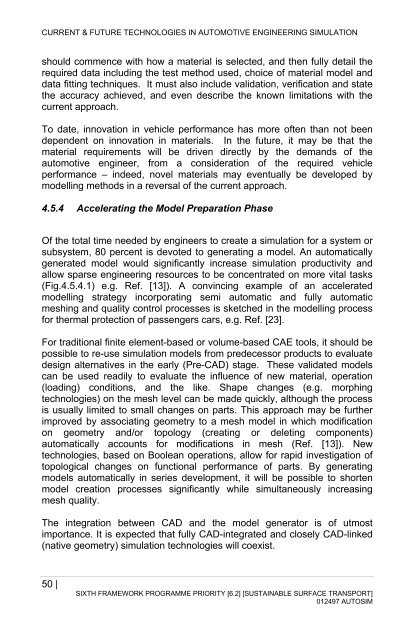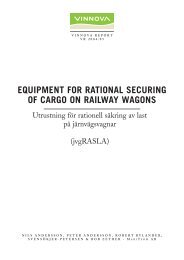Download - Autosim Autosim
Download - Autosim Autosim
Download - Autosim Autosim
Create successful ePaper yourself
Turn your PDF publications into a flip-book with our unique Google optimized e-Paper software.
CURRENT & FUTURE TECHNOLOGIES IN AUTOMOTIVE ENGINEERING SIMULATION<br />
should commence with how a material is selected, and then fully detail the<br />
required data including the test method used, choice of material model and<br />
data fitting techniques. It must also include validation, verification and state<br />
the accuracy achieved, and even describe the known limitations with the<br />
current approach.<br />
To date, innovation in vehicle performance has more often than not been<br />
dependent on innovation in materials. In the future, it may be that the<br />
material requirements will be driven directly by the demands of the<br />
automotive engineer, from a consideration of the required vehicle<br />
performance – indeed, novel materials may eventually be developed by<br />
modelling methods in a reversal of the current approach.<br />
4.5.4 Accelerating the Model Preparation Phase<br />
Of the total time needed by engineers to create a simulation for a system or<br />
subsystem, 80 percent is devoted to generating a model. An automatically<br />
generated model would significantly increase simulation productivity and<br />
allow sparse engineering resources to be concentrated on more vital tasks<br />
(Fig.4.5.4.1) e.g. Ref. [13]). A convincing example of an accelerated<br />
modelling strategy incorporating semi automatic and fully automatic<br />
meshing and quality control processes is sketched in the modelling process<br />
for thermal protection of passengers cars, e.g. Ref. [23].<br />
For traditional finite element-based or volume-based CAE tools, it should be<br />
possible to re-use simulation models from predecessor products to evaluate<br />
design alternatives in the early (Pre-CAD) stage. These validated models<br />
can be used readily to evaluate the influence of new material, operation<br />
(loading) conditions, and the like. Shape changes (e.g. morphing<br />
technologies) on the mesh level can be made quickly, although the process<br />
is usually limited to small changes on parts. This approach may be further<br />
improved by associating geometry to a mesh model in which modification<br />
on geometry and/or topology (creating or deleting components)<br />
automatically accounts for modifications in mesh (Ref. [13]). New<br />
technologies, based on Boolean operations, allow for rapid investigation of<br />
topological changes on functional performance of parts. By generating<br />
models automatically in series development, it will be possible to shorten<br />
model creation processes significantly while simultaneously increasing<br />
mesh quality.<br />
The integration between CAD and the model generator is of utmost<br />
importance. It is expected that fully CAD-integrated and closely CAD-linked<br />
(native geometry) simulation technologies will coexist.<br />
50 |<br />
SIXTH FRAMEWORK PROGRAMME PRIORITY [6.2] [SUSTAINABLE SURFACE TRANSPORT]<br />
012497 AUTOSIM
















